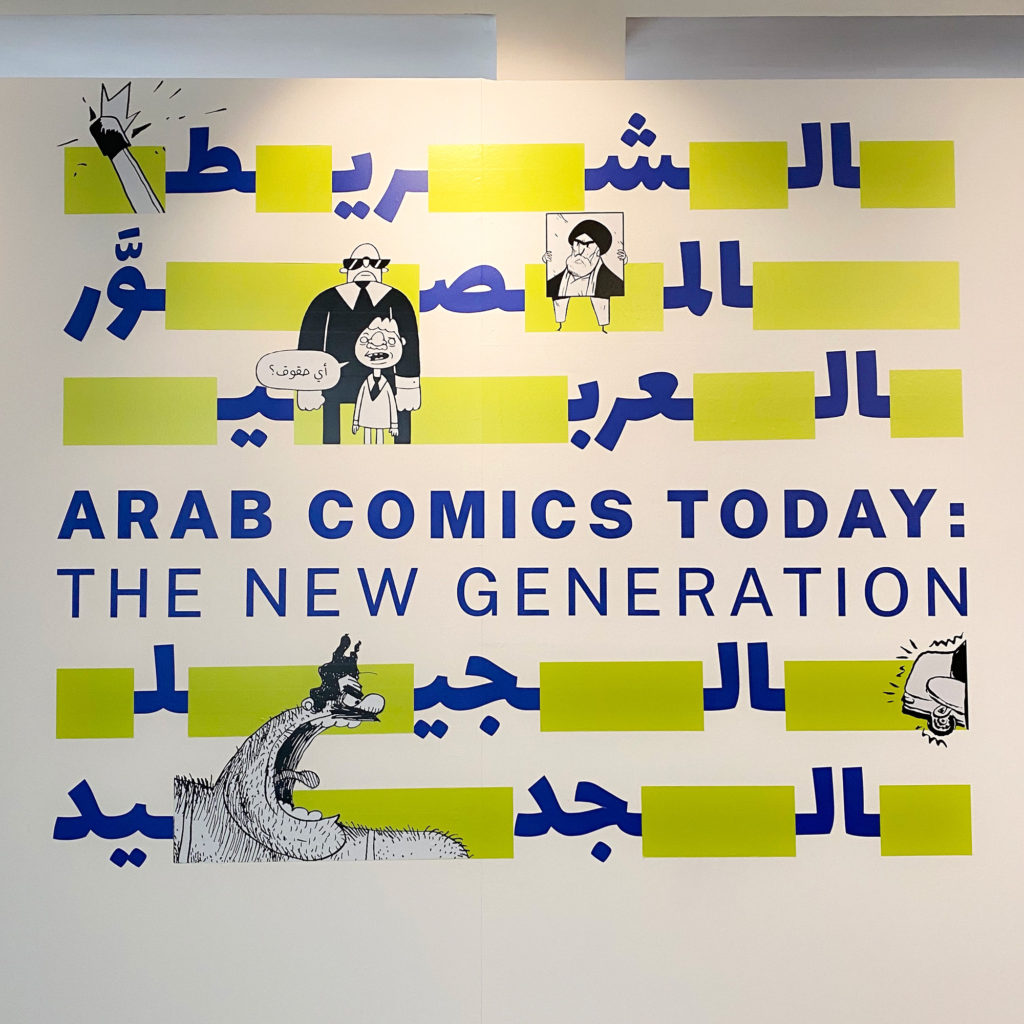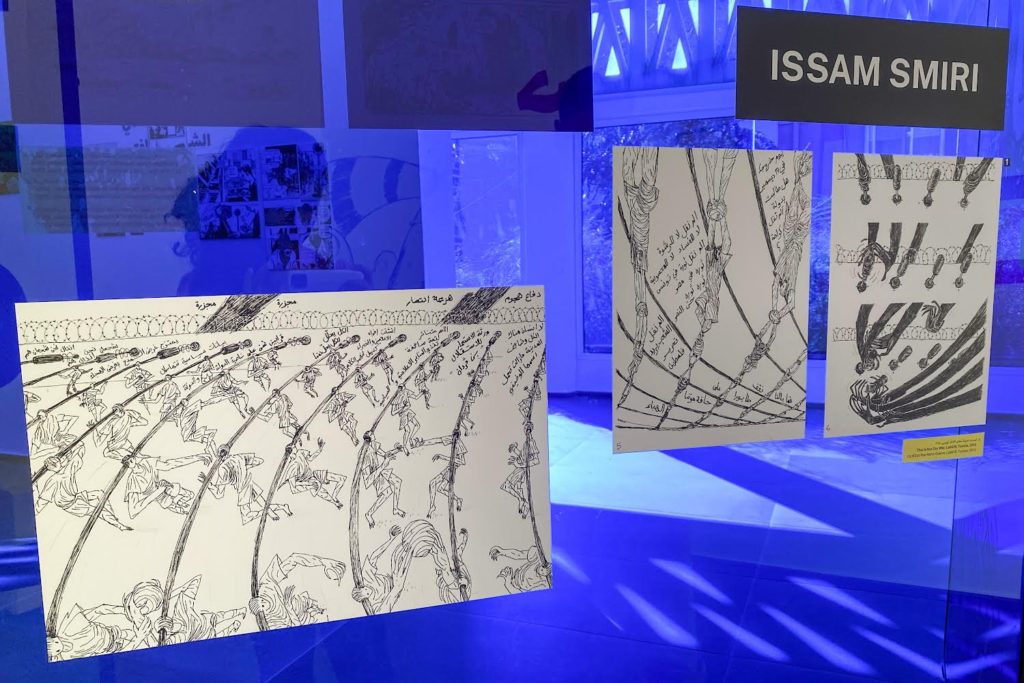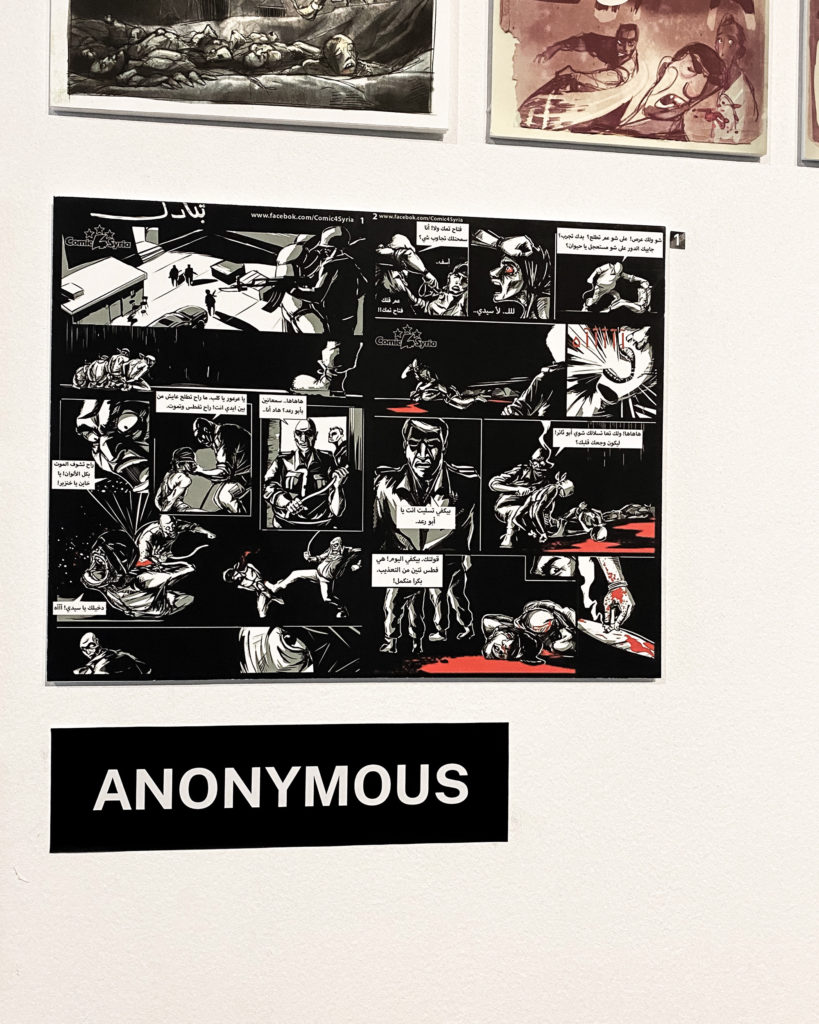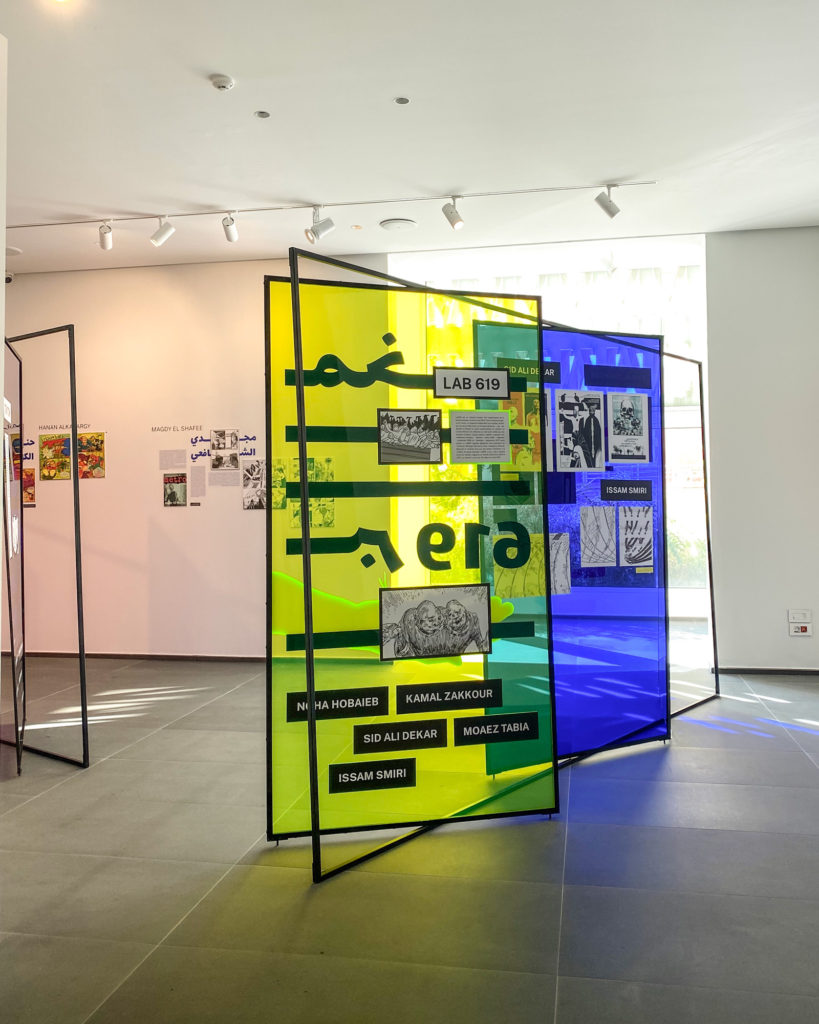By Yaman To’meh
Content Warning: This exhibition review includes mention of revolution, police brutality, surveillance, the military and other forms of state violence. Images also contain similarly sensitive material.
All photos are credited to Yaman To’meh.

In the presence of defined spatial memory, comics are the art form for expression: Each designated frame expresses a certain memory , with the blank spaces between the panels suggesting causality or sequence. Comics become a mapping of the bodies: an archive recording space and time with the complexity of the events documented. Comics are a form of preservation of the particular event being depicted within an intimate diary-like frame, especially when drawn by hand; they are a testimony to the artist’s archive of memories, a frozen moment to resurrect and to be built upon reality as it forms.
Comics are still an alternative form of expression in the Arab world, not part of mainstream media. They interact with the political and personal in the least curated manner –they play by fewer rules than other forms of expression– to taunt censorship. They offer an intimate view of the artist’s personal narrative and thus, allow for insight into the artist’s experience of life. Comics can function as a political player when created by collectives of artists and writers, creating a movement parallel to the institutional mainstream. This movement can, in itself, be a communal art production space used to reflect on and analyze reality and its alternatives. It can be a space that can evade censorship and question systems of authority through its subtle medium and form.
The Mu’taz and Rada Sawwaf Arab Comics Initiative at the American University of Beirut organized the exhibition Arab Comics Today: The New Generation at Dar El Nimer for Arts & Culture in Beirut, which ran from October 7th 2021 till January 29th 2022. The exhibition featured comics drawn by 60 artists of the ‘new generation’ and 11 collectives from the Arab world. Each collective gathers a distinctive community of artists: Samandal and Zeez Collective from Lebanon, Comic 4 Syria, Fanzeen from Jordan, TokTok and Garage from Egypt, Halal Fanzine, Lab619 from Tunisia, and Skefkef from Morocco. The comics cover the artists’ political realities, framing their experiences and the social dynamics behind them. The portrayals include the mundane details of everyday life as much as the trauma of social upheaval.
Looking through the comics at Arab Comics Today, you realize that a general sense of defeat and depression dominates the majority of the art on display. Take, for instance, Hussein Adil’s The Eyes of Revolution from Iraq, which depicts images of martyrs and blood in the streets as well as the police violence faced by the protestors. In some ways, the pieces are an archive of milestones in collective Arab memory. Adil documents revolution, but also takes count of its losses. The work is also a moment of reflection on what the future might hold. The joy of the crowds is foregrounded by their grief over all of the deaths at the hands of the police. Frames show police soldiers directing their weapons at the crowds, with a dead body on the ground in the following frame. The comic ends with a wall collaging the faces of the martyrs.

This duality of the highs of revolution –when it is joyful– and its price-to-be-paid continues throughout the exhibition. In his comic The Prisoner, the Egyptian artist Muhammad Mustafa illustrates a military guard paying careful attention to his environment and clothing from a micro- and macro-point of view: the piece both immerses us in his presence and reflects on the guard’s loneliness on a beach, using shaded black and white colors. Mustafa closely shows us the guard in his small shack with frames focusing on his face and boots along with his body language, which reflects intimidation and preparation. This is in contrast to the macro-view of the setting that the comic presents us with, which shows us that the guard is alone on the beach and thus, his presence is not required. Additionally, the comic frames him in with grey shades.
This duality is also present in Moroccan Brahim Rais’s comic depicting the military: it portrays a fight between underground dogs and soldiers set in dim grays and greens, creating an apocalyptic mood.
Tunisian Issam Smiri’s work portrays bodies in the abstract, tied together, captioned with words like “defeat,” “victory,” “massacre,” or questions: “Didn’t we say that the people want to liberate Palestine?” or ”Why are we standing in line on the verge of our deaths?” It articulates a certain interplay between the text and the image, the literal and the visual, to portray and question the progress of events and their conclusions: What will the outcome of post-revolution be? What is possible after hope is defeated? What happens to our bodies when we can’t claim them anymore? What happens to us when defeat is clear?

As a form, comics manifest as therapy, dissecting violence as it occurs and presenting the choices ahead. Events are decoded within a four-sided frame, articulating the voices of the artists’ personal and political experiences. In Arab Comics Today, Farid Nagy’s contribution is the perfect example of this form of narration. The character, shaded in grey in a black realm, asks himself, “What common sense would allow you to abandon your dreams for a bit of stability or living expenses?” Then he asks himself, “Who are you?” Nagy narrates the possibilities present under our oppressive capitalist systems, the horizons of dreams and the general psyche of self-perception indicated by the drawing of a huge black ghost overwhelming the main character’s head. The comic ends with the statement: “This place isn’t your place,” reflecting the state of alienation present in ourselves. Nagy’s comic is a great example of the intimate insight that comics provide, offering us entry into the character’s mind to learn about their fears and dreams; a reflection of their psyche as capitalism intertwines with our small victories over dictatorships, imperialism and other global systems.

Some comic artists participating in the exhibition have kept their identities anonymous for their personal safety and the violent outcomes they would otherwise likely face at the hands of the governmental authorities in their respective countries. Creating these comics is a form of agency; of reclaiming the right to expression through the artist’s personal lens. It’s a political act, especially in light of the restrictions this generation experiences through censorship and surveillance, carried out with the desperation of the post-revolutions decade. Comics have turned into entries in the archive of the self, defying oppressors by narrating the stories of the victims. The artform turns into an act of defiance, of claiming a presence by intertwining storytelling text and visuals. It takes form as a dissection of the self, to be shown to the audience.
According to Hillary Chute, a junior fellow in literature at the Harvard Society of Fellows, comics have often been considered a lesser narrative form because they don’t carry heavy text. However, instead of viewing the artform as text-light, we should understand it as an artform that leaves narration to the audience to some extent. They must reflect upon what they’re seeing and what is being narrated by the artist through what narrow frames and few words are available.
Comics form a space where an alternate reality can take form, where horizons can be reimagined to move beyond the defeat of the darkness and to inform the present and produce a “new generation;” a generation that values the memory’s ability to reproduce and reimagine beyond the decaying present. They can document and dissect events and realities to ground us beyond them.
Yaman To’meh is a visual designer with a BS in Graphic Design from the Lebanese American University (LAU). She works as a research assistant at The Arabic Design Archive (formerly The Arabic Book-Cover Design Archive), an archive aspiring to become a rich visual resource for researchers and designers. She is interested in Arab culture, specifically language. She continues to research dimensions of identity and its history. Through her works, she seeks to contribute to language and belonging, both pushing it forward and underscoring its history, all to produce more equitable systems.

